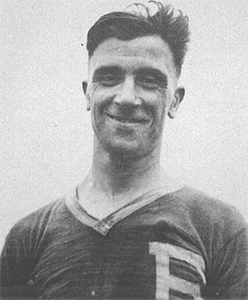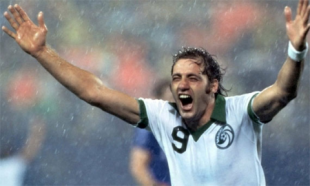A few weeks ago, we went back and compared Chris Wondolowski’s 2012 campaign with that of Roy Lassiter’s in 1996, trying to determine which striker’s 27 goal season was better. Using some very basic statistical analysis, we concluded that goals were harder to come by now as opposed to MLS’ inaugural season, and that Wondo won the “tie-breaker.”
Regardless of whether they agreed with the assessment, there was one question everyone next asked: how does Wondolowski’s MVP season stand up against all-time American soccer goal scoring records? Must be pretty impressive, right?
An 87 year old world record
It will come as a surprise to many to learn that MLS’ all-time single-season best is still a far cry from similar records in other American D1 leagues. In the wake of Lionel Messi’s goal scoring feats last year, some may have heard that the record he broke belonged to Archie Stark of Bethlehem Steel. In the 1924-25 American Soccer League campaign, the Scotland-born, American-bred Stark scored an incredible 67 goals in 44 games (with another three in league cup play, for a total of 70).
As with many single season records regardless of sport, Stark benefited from expansion; that year, the ASL grew by half (from eight teams to 12), and Stark happily ran up 32 of those goals (more than Wondo’s entire 2012 season) against the ASL’s bottom four teams. Alas, 21 of those goals were at the expense of Philadelphia sides, as Fleisher Yarn and Philadelphia FC finished 1oth and 12th, respectively. Nevertheless, in the era of 2-3-5 and offensive soccer, Stark’s accomplishment was one for the ages: he outpaced the second leading scorer that year (Andy Stevens of Boston Wonder Workers) by thirty four goals.
During its ten year run, the first ASL produced several individuals who scored more than 27 goals in a season: Daniel McNiven (Bethlehem Steel) lead the league in 1922-23 with 28 goals in 22 games, while Stark’s record-shattering 1924-25 season also saw Stevens (33 in 32 games) and Harold Brittan (Fall River Marksmen—32 in 34 games) eclipse Wondo’s total.
The 1924-25 season saw the opening of the floodgates, as subsequent seasons (and continued expansion) produced much higher goal totals. The 1925-26 season saw six players eclipse the 27 goal mark in a 44 game schedule, 1926-27 saw six score 27 or more (44 game schedule), and 1927-28 found five players scoring 27 or more in the league’s first attempt at an apertura/clausura format of up to 55 games (as scheduling was much more fluid back then, and—depending on whether games would effect the overall standings, games cancelled for weather were not always made up). Finally, in a 1928-29 season that found several top teams temporarily leave the league due to the “Soccer War,” five players scored more than 27 goals. The ASL’s final seasons still found players eclipsing the 27 goal mark, but in nowhere near the numbers of the league’s peak.
Of course, you are probably thinking the ASL is not a good comparison, as an era of five forwards and lengthier schedules would obviously lead to more goals for everyone than in MLS. The point would be a fair one. So how does he stack up in the modern era?
MLS v NASL
In 1968, the NASL’s first season (as 1967 found two leagues competing for U.S. D1 supremacy; these two subsequently merged to form the NASL), John Kowalik of the Chicago Mustangs and Cirilo Fernandez of the San Diego Toros each scored 30 goals; Kowalik netted his in 28 games, while Fernandez scored his in 29 matches. (By the way, the NASL collapsed after the 1968 season, with 12 teams folding after the season. While the league survived, so many were convinced that the league was done for that most of the circuit’s 1968 records were simply thrown away. As a result, as late as 1978 only Kowalik’s 30 goal record was known to the league—it wasn’t until 1980 that historians discovered that Fernandez also scored thirty goals that year.)
Not surprisingly, it took another wave of massive expansion to provide years in which strikers started finding the net at record-setting paces. With the addition of six new teams in 1978 (for a total of 24), two players were able to crack the 30 goal mark (or, for that matter, reach 27 goals) for the first time since 1968: Giorgio Chinaglia (New York Cosmos) scored 34 goals in 30 games, and Mick Flanagan (New England Tea Men) scored 30 in 28 games. Chinaglia thus holds the modern American single-season scoring record.
Two years later, Chinaglia scored 32 goals in 32 games, and Luis Fernando (Los Angeles Aztecs) scored 28 in 28 games. The 1980 season was also significant in that Chinaglia scored a stunning 18 goals in eight playoff games, giving him a total of 50 in all competitions. Seven of those goals came in one game against a hapless Tulsa Roughnecks side. Chinaglia continued to be a dominant scorer in 1981, netting 39 goals in 32 games. That year, however, was the last that saw any NASL player score more than 27 in a season, as a considerable post-season contraction restored levels of parity.
Certain advantages
As can be seen, Wondo’s season compares rather favorably to the best NASL seasons, although in every case the scorers from that league accomplished his feat in fewer games. However, the NASL provided certain advantages for scorers not seen in MLS. For starters, the post-1968 feats were accomplished with the aid of the 35-yard line, an NASL rule change that held that players could not be called offside until they were beyond that point. While designed to increase scoring, the move was also a practical attempt to “stretch” fields that were often narrow, as NASL teams played on gridiron fields or squeezed onto baseball diamonds.
Another advantage Chinaglia and his peers enjoyed were overtime periods. Starting with the 1974 season, NASL matches did not end with ties; unlike early MLS seasons, though, tie matches did not immediately proceed to a shootout, but found the teams playing overtime periods. That said, none of Chinaglia’s 34 goals in 1978 came in overtime.
Finally, there was much less parity in the NASL than there is in MLS. While older fans remember the consistently great clubs of that era—New York Cosmos, Vancouver Whitecaps, Tampa Bay Rowdies, etc.—some truly pathetic sides also played from 1978-81, including your Philadelphia Fury. Not surprisingly, the days of 27 or more goals a season ended after the Great Retraction of 1981, which found six teams fold after the season. With the defensive talent pool less thin, goals were simply harder to come by.
Chris Wondolowski’s 2012 season is certainly one for the American modern era, if not all time. However, there is one other category in which his season needs to be evaluated, and where his MVP performance truly stands out. Next time, we will compare Wondo’s 2012 season with the great scoring seasons of other native-born Americans.





This post makes me miss ole Giorgio on The Football Show.
Very interesting read. Great stuff!
I agree- fun read…but PLEASE leave me with my imagination of the great soccer that I thought I saw with the Fury! The Vet, seeing Pele, Beckenbauer, Chinaglia…It was good enough to keep me looking for good soccer live and on television for the next thirty years.
Tim: fear not–you still saw great soccer. Just never by the guys in yellow…
That is probably true. By the way- nice work on that old Atoms article as well on the American Soccer History Archives. Again, I saw them and thought I was in heaven with the ability to watch whole games played by real players.
I thought that was really interesting. Thanks for the unusual post. Ill keep checking back on this.
I think Jonathan Wilson would approve. Well done Steve!!!
It could be a great and beneficial bit of information and facts. We are satisfied which you distributed this helpful information with us. Remember to stop us up to date this way. Many thanks for giving.